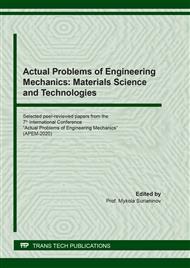p.19
p.27
p.35
p.43
p.53
p.59
p.66
p.73
p.80
Determination of Transition Stages of Structure Formation by Experimental Data
Abstract:
The paper describes the methodology of processing of the experimental data from the study of the hardening process of the binder paste, which allows to reveale information hidden in the results and objectively divide the period of structure formation into steps that differ in mechanisms and conditions. The proposed method has a universal character, is designed to study compositions of a heterogeneous structure and is implemented using experimental data on the plastic strength of gypsum binder paste as a simplified model of such a composition. It consists of two stages - the transition to normalized values and coordinate transformation to adequately display the observed processes of structure formation. To determine the type of the corresponding coordinate transformation, Erofeev and Kolmogorov equations were considered, which describe, in particular, crystallization processes. Based on the proposed equations, a physically reasonable choice of coordinate transformations of the re-logarithmic type was carried out. Processing the data on the plastic strength of the hardening gypsum binder paste as a model of the composition of an inhomogeneous structure allows us to identify the main stages of structure formation characterized by linear dependencies and transition stages in which qualitative transformations of the regime of change in plastic strength during hardening are observed. The separation of the total time of structure formation at the step is fixed on the graphs of changes in the corresponding properties, and the transition stages correspond to the points of change in the angular coefficients of the obtained dependencies. It is shown that the stationary step of structure formation corresponding to the stable maintenance of supersaturation is reflected in the general linear section on the graphs. It is shown that the time of occurrence of transition stages recorded during the measurement of plastic strength approximately corresponds to the setting time obtained by regulatory methods. A geometric interpretation of the angular coefficients of the obtained dependences which allows one to determine the structure of growing nuclei of a new phase was considered. The proposed technique can be applied to control the processes of structure formation of heterogeneous composition compositions.
Info:
Periodical:
Pages:
53-58
Citation:
Online since:
September 2020
Authors:
Price:
Сopyright:
© 2020 Trans Tech Publications Ltd. All Rights Reserved
Share:
Citation:


